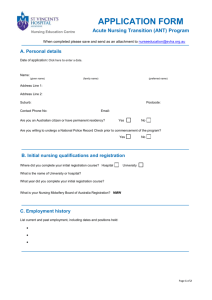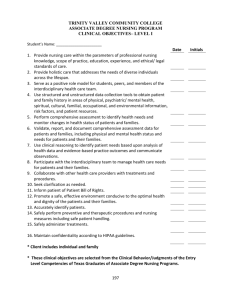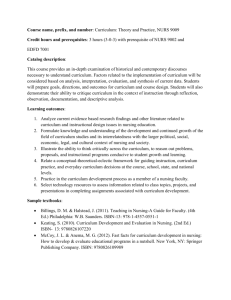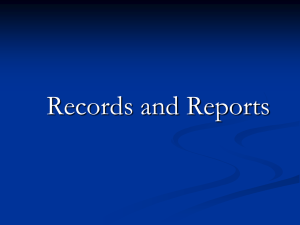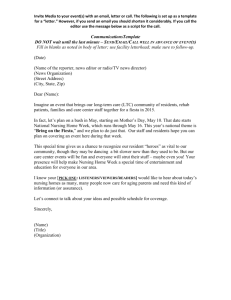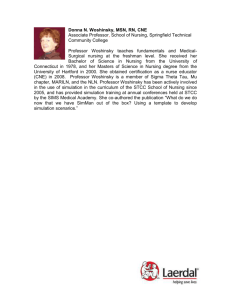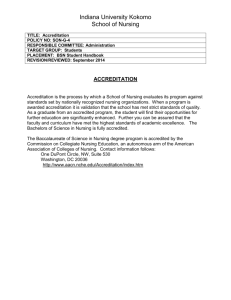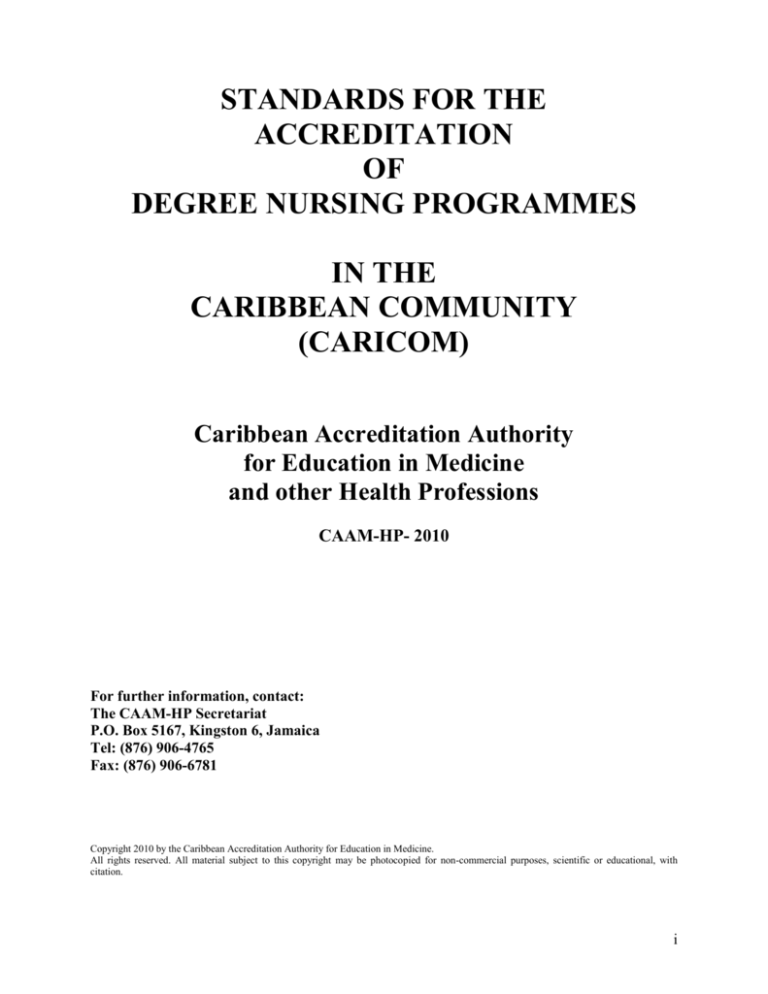
STANDARDS FOR THE
ACCREDITATION
OF
DEGREE NURSING PROGRAMMES
IN THE
CARIBBEAN COMMUNITY
(CARICOM)
Caribbean Accreditation Authority
for Education in Medicine
and other Health Professions
CAAM-HP- 2010
For further information, contact:
The CAAM-HP Secretariat
P.O. Box 5167, Kingston 6, Jamaica
Tel: (876) 906-4765
Fax: (876) 906-6781
Copyright 2010 by the Caribbean Accreditation Authority for Education in Medicine.
All rights reserved. All material subject to this copyright may be photocopied for non-commercial purposes, scientific or educational, with
citation.
i
STANDARDS FOR THE ACCREDITATION
OF
DEGREE NURSING PROGRAMMES
Caribbean Accreditation Authority
for
Education in Medicine
and Other
Health Professions
CAAM-HP- 2010
For further information, contact:
The CAAM-HP Secretariat
P.O. Box 5167, Kingston 6, Jamaica
Tel: (876) 906-4765
Fax: (876) 906-6781
Acknowledgement. The Liaison Committee on Medical Education of the United States and Canada has given
permission to the Caribbean Accreditation Authority to use the format for adaptation of their document
entitled ‘Functions and Structure of a Medical School; LCME 2002’.
ii
TABLE OF CONTENTS
INTRODUCTION
1
A.
B.
C.
D.
E.
1
1
2
2
3
Accreditation
Goals
Criteria for Evaluation
Areas
Use of Standards
ACCREDITATION STANDARDS
4
I.
INSTITUTIONAL SETTING
A. Governance and Administration
B. Vision, Mission, Values and Strategies
C. Academic Environment
D. Safe and Positive Practice Environments
4
4
6
6
7
II.
STUDENTS
A. Admissions
B. Visiting and Transfer Students
C. Student Services
1. Academic and Career Counselling
D. The Learning Environment
E. Student Assessment
F. Student Representation
7
7
9
9
9
10
11
11
III.
EDUCATION PROGRAMMES
A. Curriculum Development and Management
B. Clinical Teaching Programme
C. Teaching and Evaluation
D. Geographically Separated, On-line and Franchise Programmes
E. Programme Assessment and Renewal
F. Programme Effectiveness
1. Outcomes
12
12
15
17
18
18
20
20
IV. FACULTY AND STAFF
A. Number, Qualifications and Functions
B. Personnel Policies
C. Professional Development of Faculty and Staff
20
20
22
22
V.
EDUCATIONAL RESOURCES
A. General Facilities
B. Finances
C. Information Resources and Library Services
22
22
23
24
VI. CONTINUING PROFESSIONAL EDUCATION
24
iii
STANDARDS FOR THE ACCREDITATION OF UNIVERSITY SCHOOLS OF
DEGREE NURSING PROGRAMMES
INTRODUCTION
A. Accreditation
Accreditation is a peer review process designed to attest to the educational quality of new and
established educational programmes.
The Caribbean Accreditation Authority for Education in Medicine and other Health Professions
(CAAM-HP) is established to accredit dental, medical, veterinary and other health professions
education programmes leading to professional degrees required for practice in CARICOM
member states. By assessing and judging the compliance of professional education programmes
with nationally and internationally accepted standards of educational quality, this accreditation
agency serves the interests of the general public in the CARICOM member states and the interest
of the students enrolled in the programmes of the schools. The Accreditation reports are intended
to confirm to member governments, registration bodies (local, regional and international), as
well as education institutions, the quality of the programmes offered by the participating
institutions.
B. Goals
The goals of the accreditation process are to:
1. Develop quality nursing education programmes, consistent with the ideals of the profession,
the society and the parent institution and which meet the requirements of the profession’s
regulatory bodies.
2. Produce nurses for the region who are educated to function responsibly in diverse health care
environments, contributing to health promotion and maintenance services; nurses who
provide care to individuals across their lifespan, to families, groups and communities with a
variety of health problems.
3. Develop within nursing graduates a keen awareness of the values of the profession of
nursing.
4. Foster systematic enquiry into the nursing and health care system.
5. Evaluate programme outcomes relative to the institution’s mission, vision and programme
objectives.
6. Create awareness of the value of continuing quality improvement of the education
programmes and their impact on the development of the profession and its contribution to
positive health outcomes.
1
7. Assure the public of the competence of the graduates of these programmes and their ability to
practice ethically and safely.
Emphasis is to be placed on professional nursing competence on graduation, valuing and
observing self-directedness for life-long learning in maintaining personal and professional
development.
Evidence of education in ethical standards, evidenced-based decision-making and clinical
competence, is a primary focus in establishing these standards for professional nursing
education.
C. Criteria for Evaluation
The following three values or qualities are essential to the development of an educational
programme, and are the criteria against which all aspects of the programme are judged.
Relevance: The extent to which the goals, activities and outcomes of the nursing educational
programme(s) are a response to the health needs of a society.
Relatedness: The inter-relatedness of the parts of a nursing education programme, i.e.,
curriculum, teaching of nursing, practice of nursing and research, and administration, and their
influence in developing and achieving programme goals.
Accountability: The extent to which the nursing school values its primary responsibility of
teaching the student, its relationships with stakeholders, and developing within the students the
obligation to embrace the responsibility for safe and ethical patient care.
D. Areas
CAAM-HP has identified the following six areas as essential to quality education in nursing and
has formulated its accreditation standards accordingly.
I. Institutional Setting
II. Students
III. Education Programmes
IV. Faculty and Staff
V. Educational Resources
VI. Continuing Professional Education
These standards identify basic elements that are required of all accredited nursing education
programmes, while allowing for creativity in the pursuit of excellence in programme
development and execution.
Each standard, written to provide an inter-related and holistic view of the programme, is
supported by criteria and annotations, which elaborate the respective standards and guide and
enhance the accreditation evaluation process.
2
To achieve and maintain accreditation, degree nursing programmes must meet the standards
portrayed in this document.
The standards have been compiled consistent with global nursing accreditation authorities
including WHO, Australia, Canada, Europe, and the USA.
E. Use of the standards
This document presents the CAAM-HP accreditation standards for degree nursing programmes
in the Caribbean Community (CARICOM).
The standards are intended to guide the university schools of nursing in the development,
implementation and evaluation of their nursing education programmes.
It is the responsibility of the university nursing school to seek accreditation of its programme(s)
by CAAM-HP.
3
ACCREDITATION STANDARDS
I.
INSTITUTIONAL SETTING
A. Governance and Administration
IS.1
The nursing school’s defined governance structures and functions, including the
responsibilities and privileges of administrative officers, faculty, students and
committees, are promulgated in the university by-laws and in the nursing school’s
handbooks.
IS.2
The defined administrative structure and functions, including committees of the nursing
school must show their relationships within the university, and indicate the autonomy of
the school’s faculty as a body responsible for decision-making affecting all aspects of the
professional education programme.
A description / flow chart of the governance and administrative structure should
be available.
IS.3
The governance and administrative committees of the school should have representation
from academic staff, students and other stakeholders.
The roles of the faculty and students and other stakeholders in the governance of
the programme should be clearly defined and known to all.
Important areas where there must be direct faculty involvement include
admissions, curriculum development, implementation and evaluation, student
promotions and policy formulation.
There should be evidence produced of regular meetings of stakeholders for
members to discuss the school’s policies and practices.
IS.4
The nursing school should have a link with the Ministry of Health and institutions
providing different levels of care, to serve as a conduit for pertinent information related
to the needs of the health sector.
IS.5
The governing body responsible for oversight of the nursing school is composed of
persons who have the educational needs of the institution as a primary interest and have
no conflict of interest in the operation of the school, its clinical facilities, and/or other
related teaching or service facilities.
IS.6
The terms of office of governing body members should be of sufficient duration to permit
an understanding of the programmes of the nursing school and their operation.
4
IS.7
Administrative officers and members of the faculty must be appointed by, or on the
authority of the governing body of the school or its parent institution.
Written policies on appointments of officers and faculty should be presented.
IS.8
The director or chief official of the nursing school must have access to the administrative
head of the university or other university official charged with final responsibility for the
school, and to other university officials as are necessary to fulfill the responsibilities of
the office.
IS.9
There should be a clear understanding of the authority and responsibility for nursing
school matters among the administrative officials of the university, the director of the
school, the faculty, and the administrative officials of other components of the teaching
complex and of the university.
IS.10 The nursing school administration should include such associate or assistant directors,
programme coordinators or other such staff as are necessary to accomplish the mission
and strategies of the school.
Areas that require administrative support include admissions, student affairs,
academic affairs, faculty affairs, postgraduate education, continuing education,
clinical sites relationships, research, and business, planning, and fund raising.
An organizational structure of the administration of the school should be
presented.
IS.11 There should be evidence of active attempts to address excessive turnover or longstanding vacancies in school leadership, where a vacancy could negatively impact
institutional stability, especially planning for or implementing the educational
programme.
IS.12 The nursing school should interface constructively with other disciplines in the parent
institution, clinical practice sites, professional organizations, government and nongovernmental organizations (NGOs) and with regional and international partners.
IS.13 Regular evaluation of the nursing school director's effectiveness in advancing the vision,
mission and strategies of the school and in leadership and administration of the
programme is done.
IS.14 A system of record keeping of matters pertinent to the school’s administration,
educational programmes and student’s affairs must be kept.
IS.15 Students and other records are kept confidential, according to the school’s written policy
on such matters.
5
B. Vision, Mission, Values and Strategies
IS.16 The university nursing school must have defined statements of its vision, mission, values
and strategies, which are congruent with those of the parent institution, and the guidelines
for the preparation of the professional nurse.
The educational programmes of the nursing school must be designed to provide
their graduates with general professional competencies that are appropriate for
entry to nursing practice, ethical and safe patient care, life-long learning, and
serve as the foundation for advanced nursing education.
IS.17 The vision, mission, values and strategies of the nursing school are defined by its
principal stakeholders, which include the director, faculty, the profession, university,
health authorities and wider society.
Documentation of the school’s vision and mission statement should be presented.
IS.18 The strategies should portray the educational process that would result in a professional
nurse competent to practice in CARICOM countries, in keeping with the roles of
professional nurses in the health care system, and with an appropriate foundation for
pursuing advanced education in nursing.
The strategies should support research and evidence-informed practice and be up
to date within the context of the parent university mandates, health system
strategic goals, and expectations for professional practice.
IS.19 The governance and administration of the nursing school should promote its vision,
mission and values and facilitate the achievement of its strategic objectives.
The vision, mission, values and strategic objectives are accessible to current and
prospective faculty and students.
Evidence should be available to show that the faculty regularly evaluates the
adherence of these statements with programme preparation, delivery and
evaluation.
C. Academic Environment
IS.20 The nursing school is a component of a university which should be registered in the
country where it is based. The University should offer other graduate, research and
professional degree programmes that contribute to the academic environment of the
nursing school.
Documentation of the legal status of the nursing school or Parent University must
be presented.
6
IS.21 Faculty and students must have the opportunity to participate in research and other
scholarly activities of the school and university.
Evidence of research work undertaken by the faculty/students in the school should
be presented.
IS.22 Faculty members should work mutually in teaching, research, and appropriate health care
delivery programmes.
There is evidence of close interaction among faculty members in the various
disciplines and an understanding of the relevance and integration of the various
disciplines to nursing practice and nursing education.
IS.23 The nursing school must meet the accreditation / registration requirements as outlined by
the recognized accreditation authority in the country where it is based.
Documentation of any national accreditation status is presented.
D. Safe and Positive Practice Environments
IS.24 The nursing school must create and maintain a safe and positive work environment for
faculty, staff and students.
The nursing school director ensures that appropriate systems and protocols for
safe practice environments, risk management and safety are employed within the
workplace by all faculty, staff and students.
There must be written policies and strategies which are congruent with the parent
university’s established policies and procedures, for developing and maintaining a
positive work environment, including strategies for dealing with grievances,
workplace stress, discrimination and violence.
II.
STUDENTS
A. Admissions
S.1
Students must meet the minimum admission criteria defined by the university for its
degree programmes and as deemed essential preparation for completing the nursing
school curriculum.
S.2
The nursing school must develop and publish policies, criteria and procedures for the
selection and admission of students that are made readily available to potential applicants
and their academic advisors.
7
The nursing school's publications, advertising, and student recruitment present a
comprehensive and accurate representation of the vision, mission, values and
objectives of the programme, and the school's criteria for selection and the
admissions process.
S.3
The nursing school and parent university informational materials must describe the
requirements for admission, and the qualifying degree as offered on-site, off-site or
through distance education such as on-line programmes.
S.4
The nursing school should develop and publish technical standards for the admission of
persons with disabilities in consonance with any legal requirements in the jurisdiction
where the school is established.
S.5
The final responsibility for selecting students for admission to the nursing school should
reside with a duly constituted faculty committee.
S.6
The nursing school should have a pool of applicants sufficiently large and possessing the
published qualifications to fill its entering class.
S.7
The size and characteristics of the student intake must be related to the capacity of the
nursing school at all stages of the education process.
The size of the entering class and of the student body as a whole is determined not
only by the number of qualified applicants, but also the adequacy of critical
resources:
Finances
Size of the faculty and the variety of specialties they represent
Library and information systems resources
Number and size of classrooms, student laboratories, and clinical experience
sites and facilities
Student services
Instructional equipment
Space for the faculty
S.8
The nursing school should select from among its qualified applicants students who
possess the intelligence, integrity, personal and emotional characteristics necessary for
them to become effective professional nurses.
S.9
The nursing school should have policies and practices ensuring the gender, racial,
cultural, and economic diversity of its students.
The extent of diversity needed depends on the school's vision, mission, goals, the
expectations of the community in which it operates, and its implied or explicit
social contract at the national and/or regional level.
8
B. Visiting and Transfer Students
S.10
Institutional resources to accommodate the requirements of any visiting or transfer
students must not significantly diminish the resources available to existing enrolled
students.
S.11
Transfer students from other schools for selected courses and clinical experiences should
possess qualifications equivalent to the students they will join in these experiences.
S.12
Transfer students should not be accepted into the final year of the programme except
under exceptional circumstances.
S.13
The accepting school must verify the credentials of visiting students, formally register
and maintain a complete roster of such students, approve their assignments, and provide
evaluations to their parent schools.
Registration of visiting students allows the school accepting them to establish
protocols or requirements for health records, immunization, exposure to infectious
agents or environmental hazards, insurance, and liability protection comparable to
those of their own enrolled students.
C. Student Services
1. Academic and Career Counselling
S.14
The system of academic advisory services for students should integrate the efforts of
faculty members, course directors, and student affairs’ officers with the school's
counselling and tutorial services.
S.15
There should be a system to assist students in career choice and application to any extramural or postgraduate programmes, and to guide students in choosing elective courses.
S.16
The process of applying for extra-mural and postgraduate programmes must not disrupt
the education of the students.
S.17
There must be a system in place to review and approve students’ proposed extra-mural
programmes and to ensure the return of performance appraisal by the host programme.
S.18
The school should develop financial aid resources that minimize any student
indebtedness, and provides students with essential financial aid and management
counselling.
S.19
The school must have a system of confidential counselling and health services for its
students that includes programmes to promote their well-being and facilitate their
adjustment to the physical and emotional demands of nursing school.
9
S.20
Confidential counselling or health reports should not normally be used in academic
evaluations or the promotion of students.
S.21
Health and disability insurances should be available to all students.
S.22
The nursing school must have policies addressing students’ exposure to infectious and
environmental hazards and should follow the guidelines in the jurisdiction in which they
study in determining appropriate management, including immunization.
The nursing school institutes these policies by:
Education of students about methods of prevention and control of crossinfection;
Procedures for care and treatment after exposure, including definition of
financial responsibility; and
All registered students (including visiting students) are informed of these
policies before undertaking any educational activities that would place them
or patients at risk.
D. The Learning Environment
S.23
The nursing school must define and publish the standards of conduct for the teacherstudent relationship, and have written policies for addressing violations of these
standards.
Mechanisms for reporting violations of these standards, such as incidents of
harassment or abuse, assure that they can be registered by the student and
investigated without prejudice to the student or faculty.
The policies specify mechanisms for the prompt handling of such complaints and
promote educational activities aimed at preventing inappropriate behaviour.
S.24
There should be no discrimination on the basis of gender, sexual orientation, age, race,
religion, or creed in the admissions process and throughout the nursing school.
S.25
The nursing school must publish for all faculty and students its standards and procedures
for the evaluation, advancement, and graduation of its students and for disciplinary
action.
S.26
Students records should be confidential and available only to members of the faculty and
administration with a need to know, unless released by the student or as otherwise
governed by laws concerning confidentiality.
S.27
Students must be allowed to review and challenge their records.
S.28
The school should ensure that students have adequate study space, lounge areas, and
personal lockers or other secure storage facilities.
10
E. Student Assessment
S.29
The nursing school’s written policy must ensure ongoing assessment of students’
performance in the cognitive, affective and psychomotor domains at all levels of the
educational programme.
S.30
The nursing school must define and document the methods of assessment, including the
criteria for progression in the programme.
Assessments include both summative assessment, which results guide student
progression, and formative assessment; its results guide students in the learning
process.
Assessment methods should be clear, concise and known to students.
S.31
The nursing school should ensure consistency in the application of the assessment
methods throughout the programme.
S.32
The reliability and validity of assessment methods should be evaluated and updated as
required.
S.33
There must be written policies for student transfer, withdrawal, and termination.
S.34
There must be a formal and transparent process for taking any action that adversely
affects the status of the student.
The process includes timely notice of the impending action, disclosure of the
evidence on which the action would be based, an opportunity for the student to
respond, and an opportunity to appeal any adverse decision related to promotion,
graduation, or dismissal.
F. Student Representation
S.35
The nursing school should have student representation on appropriate committees, policy
development activities and other matters relevant to the students.
Students’ participate in the early detection and correction of problems and
deficiencies associated with inter alia, course delivery including clinical
experiences.
There is evidence to show that students actively participate on select committees,
and other appropriate activities in the governance of the programme and in the
ongoing efforts to improve programme quality.
11
S.36
Students should actively participate on select committees, and other appropriate activities
in the governance of the school, programme implementation and in the ongoing efforts to
improve programme quality.
Minutes of appropriate committees showing the membership and participation of
students should be available.
III.
EDUCATION PROGRAMMES
A. Curriculum Development and Management
EP.1
The nursing degree programme must prepare graduates to function ethically and safely as
a practitioner in all health care settings, contributing to health promotion, restoration and
maintenance health services and the care of individuals across their lifespan, their
families, and in community groups.
EP.2
The nursing school faculty should have the responsibility and authority for the design,
implementation and evaluation of a coherent and coordinated curriculum; are accountable
for the programme outcomes and have sufficient resources to fulfill this mandate.
An institutional body (commonly a curriculum committee) oversees the
educational programme as a whole. An effective central curriculum authority
exhibits:
Faculty, student, and administrative participation
Expertise in curricular design, pedagogy, and evaluation methods
Empowerment to work in the best interests of the institution’s programmes
without regard for parochial or departmental pressures.
The phrase "coherent and coordinated curriculum" implies that the programme as
a whole is designed to achieve the school's overall educational objectives.
Evidence of coherence and coordination includes:
Logical sequencing of the various segments of the curriculum
Content that is coordinated and integrated within and across the academic
periods of study (horizontal and vertical integration)
Methods of pedagogy and student evaluation that is appropriate for the
achievement of the school's educational objectives.
Evidence of effective curriculum management includes:
Evaluation of programme effectiveness by outcome analysis
Monitoring of content and workload in each discipline, including the
identification of omissions and redundancies
Reviewing the stated objectives of individual courses and clinical experiences,
as well as methods of pedagogy and student evaluation, to assure congruence
with institutional educational objectives.
12
Minutes of the curriculum committee meetings and reports to the faculty
governance and director document that such activities take place and show the
committee's findings and recommendations.
EP.3
The primary health care-focused curriculum is congruent with and responsive to the
health system strategic orientation, standards and any national or regional guidelines.
There is evidence of the use of national or regional nursing regulations and other
related documents, such as internationally defined competencies for the
professional nurse and the nursing code of ethics.
EP.4
The curriculum must be designed, developed, implemented and evaluated to reflect clear
statements of expected student learning outcomes that are consistent with the overall
programme expectations.
EP.5
The curriculum scope, objectives, course descriptions, sequencing and methods of
integration should guide faculty and students progression at each level of implementation.
The educational objectives represent the cognitive, affective and psychomotor
domains consistent with the level of behaviour the student is expected to exhibit
at that particular stage of the curriculum.
Student achievement of these objectives is shown by specific and measurable
outcomes as documented in the courses and clinical practice.
EP.6
Sequence, relevance, relatedness, integration, and internal consistency should be
observed in defining curriculum statements, course objectives, and content, learning
objectives, teaching/learning methods, learning experiences, student evaluation methods
and enable students to develop life-long self-directed study skills.
EP.7
The curriculum should prepare nursing students to recognize and appropriately address
gender, cultural and religious biases in themselves and others, and in the process of
providing patient care.
EP.8
The curriculum content must cover cultural diversity and belief systems with respect to
health and illness and the manner in which people of diverse cultures and belief systems
perceive and respond to health, illness, various symptoms, and treatments.
Faculty and students should demonstrate an understanding of the manner in which
people of diverse cultures and belief systems perceive health and illness and
respond to various symptoms, diseases, and treatments.
To demonstrate compliance with this standard, the nursing school must document
objectives relating to the development of skills in cultural matters, knowledge of
international codes of professional conduct, and demonstrate the extent to which
the objectives are being achieved.
13
EP.9
The nursing school must observe the following minimum standards, applicable for
programmes of fulltime study depending on the objective of the degree programme:
a. Bachelor of Science Degree in Nursing leading to registration with a national or
regional regulatory body: At least 140 weeks of instruction delivered over at least 3 calendar years of 9 semesters or
4 academic years of 10 semesters
2,000 hours of clinical practicum
135 credits, at least 60% of these credits are dedicated to professional course
work.
b. Bachelor of Science Degree in Nursing for nurses registered with a national or
regional regulatory body when admitted to the degree programme: At least 60 weeks of instruction delivered over at least 2 academic years
400 hours of clinical practicum
60 credits, 70% of these credits are dedicated to professional course work.
EP.10 Mandatory courses for the nursing undergraduate degree programme must include
subjects from biological, e.g. anatomy, physiology, pharmacology; physical; behavioural
and social sciences; the humanities and clinical professional nursing.
EP.11 Instruction within the basic sciences should include laboratory or other practical exercises
that entail accurate observations of biomedical phenomena.
EP.12 The curriculum should include elective courses to supplement required courses.
Electives should permit students to gain exposure to and deepen their
understanding of disciplines and provide opportunities for students to pursue
individual academic interests.
EP.13 There must be comparable educational experiences and equivalent methods of evaluation
across all alternative instructional sites of the nursing school.
Courses and clinical experiences duration should be similar. The instruments and
criteria used for student evaluation, as well as policies for the determination of
grades, should be the same at all alternative sites.
The faculty who teach at various sites must be sufficiently knowledgeable in the
subject matter to provide effective instruction, with a clear understanding of the
objectives of the educational experience and the evaluation methods used to
determine achievement of those objectives.
Opportunities to enhance teaching and evaluation skills should be available for
faculty at all instructional sites.
14
While the types and frequency of problems or clinical conditions seen at alternate
sites may vary, each course or clinical experience must identify the core
experiences needed to achieve its objectives, and ensure that students receive
sufficient exposure to such experiences.
To facilitate comparability of educational experiences and equivalency of
evaluation methods, the course coordinator must orient all participants, teachers
and students, about the educational objectives and grading system used. This can
be accomplished through regularly scheduled meetings between the coordinator
of the course or clinical experiences and the directors of the various sites that are
used.
The course/clinical experiences leadership should review student evaluations of
their experiences at alternative sites to identify any persistent variations in
educational experiences or evaluation methods.
B. Clinical Teaching Programme
EP.14 The clinical teaching programme must be consistent with the curriculum statements,
courses, and objectives and define the clinical objectives, related student placements,
teaching, supervision and evaluation.
EP.15 The curriculum must prepare students for their role in addressing the realities of
demographic, epidemiological and socio-economic influences on health and health care
quality.
EP.16 Clinical experiences must cover the continuum of wellness to ill-health and include
health promotion, restoration of well-being and rehabilitation.
EP.17 Clinical experiences must include practical experiences working as a member of a multidisciplinary team.
The objectives for clinical education should include quantified criteria for the
types of patients, the level of student responsibility, duration of the experiences,
and the appropriate clinical settings needed for the objectives to be met; they
should also specify the extent of student interaction with patients.
EP.18 The nursing school’s Clinical Skills Laboratory (CSL) should have adequate space,
equipment, supplies and multi-media technology for the students to learn and practice
basic nursing skills in preparation for the administration of safe and ethical patient care at
the clinical sites.
The Laboratory contains updated learning resources such as audiovisual
equipment, scientific charts and models, and disposable and non-disposable
supplies utilized in patient care. It provides as much as possible, a simulated
15
clinical environment with various equipment and life size manikins to simulate
patient care situations.
EP.19 Nursing students must achieve mastery of selected clinical procedures through return
demonstrations in the Clinical Skills Laboratory prior to engaging in actual patient care.
The faculty should employ various methods of assessing students’ mastery. The
results must be documented and made known to students and preceptors. Students
should not provide unsupervised patient care without evidence of mastery in the
applicable clinical procedures.
Students must be required to exhibit scrupulous ethical principles in caring for
patients, families, and communities and in relating to others involved in care.
The nursing school must ensure that students receive instruction in appropriate
professional ethics, human values, communication skills, and patient and staff
safety, before engaging in patient care activities.
Adherence to ethical and safety principles must be observed, evaluated, and
reinforced throughout all formal instructional efforts.
EP.20 Clinical teaching activities should be pursued in diverse environments that best serve the
educational programme interests, such as the range and level of service and care
provided, and include health and related health sectors, regional, international
organizations/agencies, and NGOs.
EP.21 Clinical or other facilities that serve as major sites for nursing student clinical
experiences must be approved for health care delivery by the regulatory bodies in the
jurisdiction.
Students’ clinical experience sites should include primary, secondary and tertiary
level health care facilities for all ages.
Documentation of the assessment of the clinical sites by the jurisdiction
regulatory body should be available.
EP.22 The criteria used for the selection of patients, clinical settings, levels of student
participation, supervision and evaluation should be based on written programme
objectives which are made known to all students, faculty and others with responsibilities
in the education programme.
EP.23 Clinical Instructors/Preceptors, who teach, supervise and evaluate nursing students, must
be familiar with the educational objectives of the course, be competent in their assigned
specialty, and are prepared for their roles in teaching, supervision and evaluation.
16
EP.24 Supervision of student learning experiences must be provided throughout required
clinical practice and practicum by members of the school's faculty and approved staff
from the affiliated institutions/agencies.
EP.25 Written contractual agreements, which state the responsibility of the nursing school and
the agencies for placement of students for their required learning experiences, should
exist between the school and affiliated teaching sites.
EP.26 The nursing school must retain the control of the education programme for students in the
partnership between the school and the affiliated clinical sites.
C. Teaching and Evaluation
EP.27 The nursing school must demonstrate the use of recognized approaches to teaching and
learning in their programmes; approaches that reflect current and emerging trends in
education technology, adult education, self-directed learning, e-learning, clinical
simulation, and are aimed at eliciting active student participation and achieving
programme objectives.
EP.28 The faculty should employ a variety of instructional methods that satisfy the requirements
of the course objectives, content, learning experiences and student characteristics.
There should be evidence of a variety of instructional technologies, which are
current and relevant.
EP.29 The faculty of each course should collaboratively set the standards of achievement in that
course, including knowledge, attitudes and practice in the course.
EP.30 The coordinators of all courses and clinical experiences must design and implement a
system of formative and summative evaluation of student achievement in each course and
clinical experience.
EP.31 Regular feedback on students’ progress in achieving the expected programme outcomes
must be documented and made available to students and faculty and a system of
remediation implemented.
Evaluation of student performance must measure not only the retention of factual
knowledge, but the development of the skills, behaviours, and attitudes needed in
professional practice, as well as the ability to use data appropriately for solving
problems commonly encountered in practice.
Those directly responsible for the evaluation of student performance should
understand the uses and limitations of various test formats, reliability and validity
issues, and objective vs. subjective formats.
17
Courses or clinical experiences that are short in duration may not have sufficient
time to provide structured evaluation activities but should provide some alternate
means (such as self-testing or teacher consultation) that allow students to measure
their progress in learning.
EP.32 Where teacher-student interaction permits these forms of assessment, narrative
descriptions of student performance including personal qualities and interactions should
be included as part of the evaluation in all required courses and practicum.
D. Geographically Separated, On-line and Franchise Programmes
EP.33 The nursing school's administration is responsible for the quality and conduct of the
educational programmes and for assuring the adequacy of faculty and other resources at
all educational sites.
The nursing school must demonstrate the means by which faculty at dispersed
sites participate in and are held accountable for student education that is
consistent with the objectives and performance expectations established by the
course or clinical experience leadership.
EP.34 The principal academic officer of each geographical site should be administratively
responsible to the director of the parent nursing school conducting the educational
programme.
EP.35 The faculty at all sites should be functionally integrated by appropriate administrative
mechanisms.
Mechanisms to achieve functional integration can include regular meetings;
electronic communication; periodic visits to all sites by course leadership; sharing
of course or clinical experiences evaluation data and other types of feedback
regarding faculty performance of their educational responsibilities.
EP.36 The parent nursing school must assume ultimate responsibility for the selection and
assignment of all nursing students when geographically separated campuses are operated.
EP.37 There must be a single standard for promotion and graduation of students across
geographically separate sites.
EP.38 Students assigned to all sites should have the same rights, receive the same support
services and have the opportunity to move among the component programmes of the
nursing school.
E. Programme Assessment and Renewal
EP.39 The nursing school must conduct ongoing and systematic formative and summative
assessments of the performance of its current students.
18
The appropriate committee should give attention to the impact on students of the
amount of work required, including the frequency of examinations and their
scheduling.
EP.40 The nursing degree programme administration must document student progress toward
completion of the degree requirements.
EP.41 There should be a dynamic process in place for regular review and renewal of the nursing
school mission, values, strategies, structures and functions, and the educational
programme(s).
The nursing school should engage in a process of total quality improvement to
facilitate curriculum renewal and update in response to changing health and social
issues / problems and national, regional or international priorities.
EP.42 The nursing school programmes and resources should be kept current in accordance with
any change in institutional mission, strategies and policies, current trends in nursing,
epidemiology, demography, health and social conditions, health care delivery, and
nursing regulatory requirements.
The faculty committee responsible for the curriculum must monitor the content
provided in each course so that the school's educational objectives are achieved.
The committee, working in conjunction with the director/administrative head of
the school, should assure that each academic period of the curriculum maintains
common standards for content and its delivery. Such standards should address the
depth and breadth of knowledge required for a general professional education,
currency and relevance of content, and the extent of redundancy needed to
reinforce learning of complex topics. The final year should complement and
supplement the curriculum so that each student will acquire appropriate
competence in professional nursing practice.
EP.43 Accredited programmes must notify CAAM-HP of plans for any major modification of
the curriculum.
Notification should include the explicitly defined goals of the change, the plans
for implementation, and the methods to be used to evaluate the results.
The plan for change should include the incremental resources that will be
required, including the physical facilities; faculty; student facilities; demands on
library and computer facilities and operations; and equipment needs.
In view of the increasing pace of discovery of new knowledge and technology,
experimentation that aims at increasing the efficiency and effectiveness of nursing
education should be encouraged.
19
F. Programme Effectiveness
1. Outcomes
EP.44 Graduates of the nursing school should have achieved established curriculum
competencies and are prepared to practice nursing ethically and safely.
EP.45 The nursing school should evaluate the effectiveness of the educational programme,
documenting the extent to which its objectives have or have not been achieved, using the
results to guide programme improvement.
Relevant outcome measures include data on student performance, academic
progress and programme completion rates, acceptance into postgraduate
programmes, and practice characteristics of graduates.
EP.46 Students evaluation of their courses, clinical sites and teachers indicate the quality of the
programme’s performance.
EP.47 Graduates of the nursing programme meet the standards necessary for professional
registration as a nurse at a national and regional level.
EP.48 Graduates are capable of successfully undertaking advanced education programmes.
EP.49 Programme effectiveness is evidenced by:
Success rate for programme completion in the stipulated period of study
Performance in National / Regional Examinations for Nurse Registration
Job placement
Employers’ performance rating at least 12 months after graduation
Job satisfaction as evidenced by self-assessment at least 12 months after graduation.
IV.
FACULTY AND STAFF
A. Number, Qualifications and Functions
F.1
The recruitment and development of the nursing school's faculty and staff should take
into account its mission and the diversity of its student body.
F.2
The director/dean of the nursing school should have a graduate nursing degree and be
educationally and experientially qualified to provide effective leadership and
administration in professional nursing education, scholarly and other activities of the
school.
The director/dean of the nursing school has the authority to administer the
business of the school including its educational programmes. Such authority
20
extends to overall responsibility for the delivery of the nursing programmes at
geographically separate sites.
F.3
The nursing school should have a staffing plan that delineates the quantity, quality and
functions of the faculty and staff.
The profile of both faculty and administrative staff should be suitable for the
implementation of the nursing school’s vision, mission, strategic goals and
educational programme.
F.4
The core academic faculty should be registered nurses and midwives who demonstrate
knowledge as educators and have a minimum of a bachelor’s degree – preferably a
postgraduate degree, with advanced preparation and clinical competence in their specialty
area.
F.5
There must be a sufficient number and mix of faculty members in the subjects essential to
nursing to meet the needs of the educational programme.
F.6
The faculty to student ratio in the clinical areas should be sufficient to ensure optimum
student learning and safe patient care.
The number and type of faculty appointed in the clinical areas, should relate to the
level of the students, diversity of patient care, and the health promotion and
maintenance activities required.
F.7
There must be a sufficient number and mix of administrative staff for the nursing school
to meet its academic and administrative mandates.
F.8
Faculty members should have the capability and continued commitment to be effective
teachers.
Faculty members involved in teaching, course planning and curricular evaluation
should possess or have ready access to expertise in teaching methods, curriculum
development, programme evaluation, and student evaluation. Such expertise may
be supplied by an office of professional education or by faculty/staff members
with backgrounds in educational science.
Faculty involved in the development and implementation of a course, clinical
teaching, or larger curricular unit should be able to design the learning activities
and corresponding evaluation methods (student and programme) in a manner
consistent with the school's stated educational objectives.
Registered Nurses/Midwives appointed to the faculty, on a part-time basis or as
volunteers, should be able to serve as role models for students, and provide
insight into health promotion and safe and ethical patient care.
21
Among the lines of evidence indicating compliance with this standard are the
following:
Documented participation of the faculty in professional development activities
related specifically to teaching and evaluation
Attendance at international regional or national meetings on educational
affairs
Evidence that faculty members' knowledge of their specialty is current.
B. Personnel Policies
F.9
There must be written policies for faculty appointment, renewal of appointment,
promotion, granting of tenure, and dismissal that involve the faculty, the appropriate
department heads, and the director.
F.10
Faculty members must receive written information about their terms of appointment,
responsibilities, and lines of communication, privileges and benefits.
F.11
There should be a programme of on-going performance appraisal and feedback for
faculty on their academic performance and their progress toward promotion.
F.12
The school should have policies that deal with circumstances in which the private
interests of faculty members or staff may be in conflict with their official responsibilities.
C. Professional Development of Faculty and Staff
F.13
The nursing school should have a policy and system, which provides education
opportunities for the continuing professional education of its faculty and staff.
F.14
Opportunities for professional development must be provided to enhance faculty
members' skills and leadership abilities in education programme management and
research.
F.15
Research and scholarly activities that contribute to the advancement of nursing
knowledge and education programme enhancement should be conducted by nursing
faculty.
V.
EDUCATIONAL RESOURCES
A. General Facilities
ER.1 The nursing school must have sufficient resources to fulfill its responsibility for the
management and evaluation of the curriculum.
The kinds of resources needed to assure effective delivery of the educational
programme include:
22
Adequate numbers of teachers who have the time and education necessary to
achieve the programme’s objectives
Appropriate teaching space for the methods of pedagogy employed in the
educational programme
Appropriate educational infrastructure (computers, audiovisual aids,
equipment, laboratories, etc.)
Educational support services, such as examination grading, classroom
scheduling, and faculty training in methods of teaching and evaluation
Support and services for the efforts of the curriculum management body and
for any interdisciplinary teaching efforts that are not supported at a
departmental level.
The school’s facilities include offices for faculty, administrators, and support
staff; clinical skills and other laboratories;
classrooms and lecture hall (s) sufficiently large to accommodate a full year's
class and any other students taking the same courses;
space for student use, including study space;
space for library and information access.
Appropriate security systems should be in place at all educational sites.
ER.2 The university should demonstrate an ongoing commitment and support for the nursing
programme by making available resources to enable the nursing school to achieve its
mission, strategies, and expected programme outcomes.
ER.3 The nursing school must have easily accessible current and relevant information
materials, communication technology, and physical facilities including but not limited to,
offices, classrooms, clinical practice sites, and clinical simulation laboratories.
B. Finances
ER.4 The current and anticipated financial resources of the school should be adequate to
maintain a sound programme of nursing education and to attain other institutional goals.
ER.5 The nursing school should be responsible and accountable for preparing and managing a
dedicated budget that meets the requirements of the programme, faculty and students.
ER.6 Pressure for institutional self-financing must not compromise the vision, mission and
educational programme of the school, nor cause it to enroll more students than its total
resources can accommodate.
The costs of conducting the degree in nursing programme should be supported
from diverse sources, such as tuition, endowments, the parent university,
covenants, grants from organizations and individuals, and appropriations by
government.
23
Evidence for compliance with this standard includes documentation of adequate
financial reserves to maintain the educational programme in the event of
unexpected revenue losses, and demonstration of effective fiscal management of
the school’s budget.
Reliance on student tuition should not be so great that the quality of the
programme is compromised by the need to enroll or retain inappropriate numbers
of students or students whose qualifications are substandard.
C. Information Resources and Library Services
ER.7 The nursing school must have ready access to a well-maintained library and information
facilities, sufficient in size, breadth of holdings, and information technology to support its
educational programme needs.
There is physical or electronic access to leading science and professional journals,
periodicals, etc., the current numbers are available to faculty and students. The
library and other learning resource centres are equipped to allow faculty and
students to access information electronically, as well as to use self-instructional
materials.
ER.8 The library and information services staff are responsive to the needs of the facu1ty and
students.
ER.9 Educational resources including information technology and clinical facilities
technologies should be selected by faculty and are relevant, comprehensive, current, and
must be accessible to faculty and students.
Professional staff supervise the library and information services, and provides
instruction in their use. The library and information services staff are familiar
with current international, regional and national information resources and data
systems, and with contemporary information technology.
Both school officials and library/information services facilitate faculty and
students access to information resources, addressing their needs for information
during extended hours and at dispersed sites.
VI.
CONTINUING PROFESSIONAL EDUCATION
CE.1 A nursing school should provide education programmes for the continuing professional
education (CPE) of its graduates, faculty and staff. Where appropriate such programmes
should be done in consultation and cooperation with national and regional authorities to
satisfy professional practice requirements.
24
CE.2 Continuing professional education programmes should have the organisational structure
and resources necessary to provide programmes of acceptable educational quality and
promote quality of care through self-evaluation.
CE.3 Programmes should be conducted according to standards and criteria developed by the
school in keeping with any national, regional and international standards.
CE.4 A nursing school should be prepared to cooperate with national and regional authorities
in setting and the administration of professional examinations that authorities may deem
necessary to determine the competence of nurses to enter or continue in professional
practice.
CE.5 A nursing school should provide opportunities for research and scholarly activity and the
promulgation of the results of such work to the faculty, staff, students and the nursing
profession.
25


